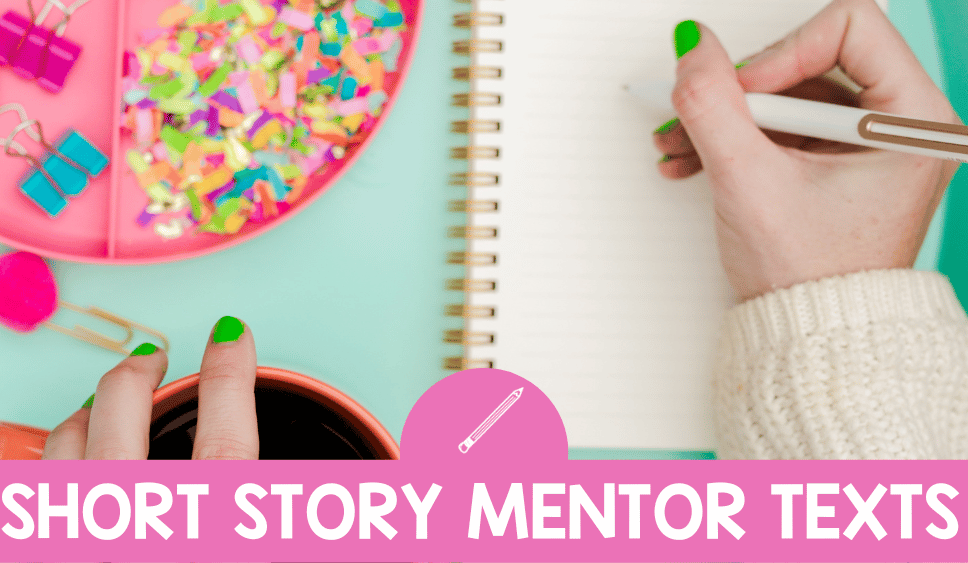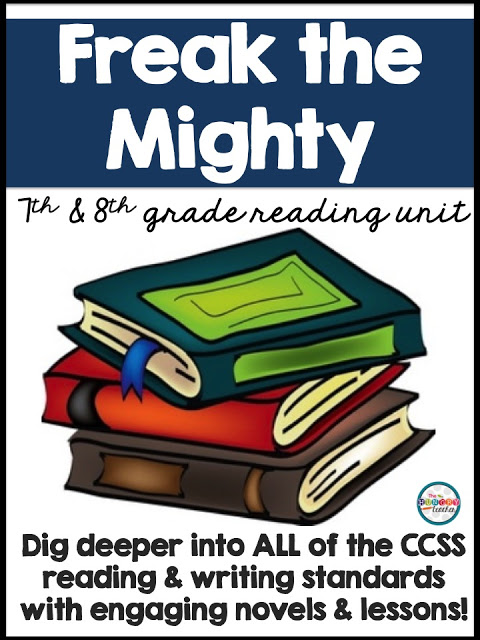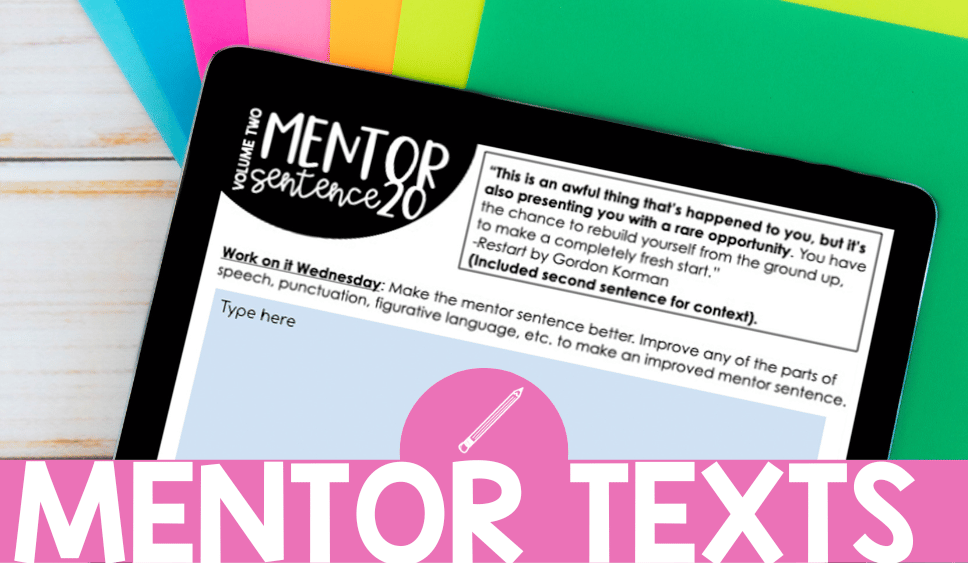
Writing Authentic Narratives in Middle School
I recently finished writing Narratives with my 7th and 8th graders. I started planning for it weeks in advance because I wanted my students to have good, strong narratives. Here is what planning looked like at first ha!
I have always done the “personal narrative” that most of us are familiar with because of the work of Lucy Calkins and writer’s workshop. I LOVE Lucy and workshop, but when I thought about narratives and what I want my students to be able to do, I started thinking about narratives differently.
Ironically, at the end of this, you will see that I actually come full circle on this…
One of my favorite things to do is have my students write from the point of view of a different character in a book. My absolute favorite narrative is Freak the Mighty, and I love having students write from Killer Kane or Freak’s point of view, instead of from Max’s point of view (as the author does).
It’s usually a wrap up assignment or something we do during the chapters when Killer Kane first makes his appearance. It’s also honestly some of the best responses I get from students all year, and I have done this assignment in grades 5th-8th.
The kids blow me away with how they get into character and use the author’s craft to write their narrative. It’s usually just kind of a reading response type assignment, but I always feel like they could do so much more with it (if I let them).
Now, when I started to think about this for narratives, I didn’t want to enhance this just because I like it and I thought it was fun (even though, that is true too!).
We take PARCC in Colorado. Now I don’t think we should be teaching to the test, but I hate how come March, I feel like I just didn’t prepare them for some of the stuff they will be asked to do. Much of which they are capable of, if someone just teaches them.
In general, the idea behind “personal narratives” is to teach students the elements of a narrative so that they can apply these skills later on. I AM SO HORRIBLE at teaching them this in the way that I think it is meant to be taught.
Long story short (but still kind of long) I just decided to look at the PARCC narrative task rubric and see what they were looking for. It was moderately simple once I was able to break it down into chunks for my students.
On a VERY similar note, testing doesn’t seem to ask them to write a “personal narrative” anymore, nor does it have them write to “cold” prompts (meaning, no more open ended narratives). I still think it’s possible to teach narratives this way, and to do it well, but I needed more direction at this point in my teaching writing career :).
In 5th and 6th grade, my students had to read a narrative story and (imagine my surprise) write from the point of view of another character.
In 7th and 8th, they seem to be asked to continue a story that they read.
But in both cases, they are looking for narrative elements and asking the reader/writer to use elements from the story they just read… and that’s pretty much it.
With the Narrative task rubric in mind, having just finished Freak the Mighty, and with a mission to have my students really push themselves as narrative writers, this is what I came up with.
Basically, I combined everything I had ever done with narratives, and made it very middle school “rigorous,” relatable, and engaging. Essentially using mentor texts, modeling and learning about narrative writing elements, and then used a workshop model (kind of an accident on that one).
First of all, we read Freak the Mighty. If you don’t know me at all, Freak the Mighty is “my book.” It’s basically everything to me, and I always like to start the year with it.
We did a combination of a kind of read aloud of the novel, and we did also use my reading unit to dig deeper as we read. I’d say 1/2 the time I just read aloud and 1/2 the time we had discussion and/or writing. I just used my 7th/8th grade reading unit for this one:
Then we also used some Lovin’ Lit interactive notebook pages to analyze the book as we read.
Lovin” Lit is LIIIIIFFFFFEEEEEEE. I use basically everything she makes.
We did the following interactive notebook activities, as we read. Some are from her reading interactive and some are from her writing interactive notebook. The interactive notebook activities were mostly designed for use to review elements of literature at first. Then we went more into conflict and plot so that they could really develop these in their writing.
We mostly did the reading ones throughout the novel, but towards the end of the novel, we started to do some of her narrative writing activities to start prepping them for the task at hand.
These pictures below here were a vital lesson for my eighth graders. This was the big distinction for 7th and 8th grade. Eighth graders were required to use one advanced plot technique in their narrative….
I kind of made this decision on the fly, because I wanted my eighth graders to have to push themselves as writers in some way. I taught them each one, gave some examples from Freak the Mighty, and then we discussed some ways they could do this in their narrative.
Many of my 7th grades had these techniques in their writing, especially foreshadowing, but I wanted my 8th graders to really have to dig deep into thinking about at least one of these.
Just for daily lesson plan reference (in case you’re wondering) we would typically spend 15-20 minutes reading and discussing the novel and then 15-20 minutes doing these interactive notebook pages. The last 10-15 minutes of my classes is devoted to independent reading time.
You could probably do this with any number of narrative texts, but again, I have no shame admitting I am 100% biased of this book. It is EVERYTHING to me. I literally just bought a hardback copy that no one is allowed to touch.
Anyway, about the time when I knew we had 4-5 days left of the novel, I started to talk about how they would be creating their own narratives. Originally, I was just trying to make it clear for due dates and such, but eventually Rodman Philbrick, became our author’s craft “king” if you will.
I told them they would have to either “become” Freak or Killer Kane so to pay attention to scenes, characteristics, dialogue, settings, imagery, etc. as we finished the book, so they could reference these sections as they went along.
At the completion of the novel I told them they would have to choose. I was very literal with this statement. Meaning we finished the book, I handed them their narrative pack and said, “You have 30 seconds to decide who you will become.”
Each students was given, what I ended up calling, “The Narrative Packet.” It was only four pages (2 pages front and back) and it was meant to be the scaffolding and support for students. Each component was pulled from a different place, but each one what based on my planning and vision for their final narratives.
This was the front page that I typed up:
I have learned from experience that kids will “think” for forever and #icanteven. I used to be such a “hippy” about stuff, and would try to let them to decide on their time, and allow all that stuff, but I have learned no one dies or has a melt down when I make them make decisions quickly. I have also learned if I give them 27 days, some kids will literally use 28 days every time. If anything, I think I am teaching them decision-making skills :).
Right after that I said, you know have 2 minutes to decide which scene you will focus on. I didn’t want them to write their own novel and I wanted them to narrow their focus. Much like how Lucy Calkins has students pick a “seed,” not a “watermelon,” story. Again, I didn’t want to spend the next four days waiting for kids to decide….
… and I didn’t have a single students say, “I don’t know what to write about.” I had given them lots of “warnings” of what was to come, they didn’t have time to get with their friends and convince each other to write the same thing, and the book was fresh in their minds.
Lastly, they were then given another 30 seconds to decide their climax. I DID NOT want to read 100 boring papers, so when we talked about the section of the books they could take on, I was very clear that it had to have a climax. I didn’t want a four page narrative on how Freak and Max meet. I wanted action!
I modeled all of this 4 TIMES. With teach class I used a new packet, because I wanted each class to see my thinking and decisions. I even switched the character and scene/climax each time. It’s easy to use the same examples for each class, but then they don’t see your thinking, and that is where I think they benefit the most.
I then talked about the rubric, which was on the back of this cover page. I honestly printed the rubric off the PARCC practice test site. It is pretty vague and board all at the same time, and is also the “generic rubric” for grades 6-11 (which seems like a very wide range to me).
But again, in all honesty, I think it helped me and them focus on the most important elements of narratives. This is what those PARCC people are looking for, and so that’s what I would be looking for. It also helped my grading a ton, because I was solely focusing on the components in the rubric.
The picture below is hard to see and you can find the actual rubric by clicking here, but I wanted you too see how I told them what each category basically meant for their grade (we literally wrote their letter grade equivalents on top of each column).
You’ll notice that we highlight toward the top of the page and it says “is effectively developed with narrative elements.” Again, vary interpretive on what that means, but on the bottom we highlighted exactly what they (and I!) mean by that. This was so students knew exactly what to include in their narrative to get their A or A+. I took the time to go over all of this for them and then made a chart to reiterate for our entire narrative unit.
Narrative elements include:
- Establishing a situation
- Organized a logical event sequence
- Describing scenes, objects or people
- Developing characters’ personalities
- Using dialogue as appropriate
- Establishing a context
- Situating events in a time or place
- Developing a point of view
- Developing character motives
This is the chart I made (this was mentioned in the picture above, for their narrative requirements).
We then used Lovin’ Lit’s plot diagram page to create the plot diagram for their narratives. They had to fill in the climax first, then the exposition, then the resolution.
I wanted to make sure that they knew the climax was the most important piece, and that they needed to build up to it. I also wanted the resolution to be a focus because I didn’t want their narrative to end with, “And that is my story,” or even “And that’s the end.” I wanted them to know how they were going to wrap up their story without leaving their reader feeling gipped.
The last page of their packet was an a narrative planner sheet I got from our Step Up to Writing program. It essentially made them have a beginning, middle, and end. Again, I made them start their plan with their climax and resolution and then go back to the start.
From here, they could start their rough drafts. I MODELED everything like a crazy person, but this is from years of getting crappy final drafts. I know if they don’t see what I am looking for they just won’t get it.
I used to think that students would just copy me, but another teacher then told me, “Isn’t that what good writers do? They use mentors and mentor texts to become better writers.” DUH! Yes, some used some of my starts and a few of my sentences, but very few did, and the few that did, just used me as a spring board!
I wrote four different rough drafts (one for each of my classes) and I really started from scratch with each, so they could see me go through the process. I tend to talk aloud and write under my document camera. When I feel like most of them can get started I say, “You can keep watching me write until you feel ready, but the rest of you can get going. I am going to stop thinking aloud now though.”
Most students start writing at this point, and the few stragglers watch me write a few more minutes and then get going. I only had one students who just couldn’t get started (out of 100!) so the next day, I told him I would “scribe” his introduction, and he had no issues from there.
While modeling I talked about introducing characters and settings the way Rodman Philbrick does, using dialogue to move the story along, describing and introducing characters/settings, creating suspense, using mentor texts, and plot techniques.
Here are pictures of a couple of my drafts.
So obviously modeling your drafting process is beneficial for students to see what you are going through, but I had HUGE revelations while doing this. I finally understood how Writing Workshop was supposed to work! I always remember how Lucy Calkins would have you stop the students to do a quick “lesson” while they were writing, but I NEVER did it, because it didn’t seem relevant once I got them writing.
This ALL changed when I was writing while they were writing. I would be writing and realize I needed to model how to correctly use dialogue by creating a new paragraph and indenting each time someone new talked… or how to describe characters without boring your reader to death… or how to use imagery.
I would come to these impasses in my writing, and then stop my students and model how to do it. In my efforts to kind of say, “Workshop” isn’t what I needed, I came full circle on my own and developed a workshop model! It was so amazing.
Basically what I am saying is that, YOU have to try writing while they are to understand how truly difficult writing is. It’s so freaking hard, takes so much work, so much thinking, so much planning, and just SO much. But if you can see and feel what they’re going through it makes you and them so much stronger as writers.
I was even able to snap some pictures of them working on their drafts:
Again, I gave them pretty strong deadlines for rough drafts. I think they ended up with about 2 1/2 to 3 days (in class) to work on their rough drafts. I didn’t want them to be “thinking” for forever. Come Tuesday in class, if they didn’t have at least two hand-written pages, it became homework. I made it a 20 points in the grade book.
This was mostly for some lessons on responsibility (I had a few who chose to talk most of class instead of writing) but also to make sure when it was time to start editing/revising and typing final drafts, that kids weren’t “done” typing their final and only had half a page. Out of a 100 students, I only had three who didn’t have the full two pages. Not surprisingly they were the three that chose to talk most of class.
On Wednesday, students had the class period to peer edit a classmates rough draft. Again, I modeled like a crazy person, stressed how difficult writing is (and to be constructive but still kind), and how this is a chance to help each other publish our absolute best work. The students were AMAZING. This is the form I created and these are some students editing and revising each others. Click here to download and editable option for FREE in my TPT store.
Finally, Thursday and Friday were devoted to them typing their final drafts. I checked out our laptop cart, and also arranged for them to type an hour in their tech class (our tech teacher is wonderful!) This gave them three full hours of typing time in school. Some ares still such slow typers, so they were given the weekend to finish typing and submitted their essays on Monday. I had about 75% finished by Friday, and the rest just did it for homework.
I started grading over the weekend and was blown away with what they produced. I have great kids, and some strong writers, but I can tell that the time spent on modeling, using Freak the Mighty as our mentor text, and peer editing was TOTALLY worth it and completely paid off.
Of course, while I am grading, I always find words that KILL me so every year I make a chart for the words that I NEED to be spelled right:
Thank you so much for staying with me friends!
Martina
Share it:
Email
Facebook
Pinterest
Twitter
- Read more about: Back to School, Middle School Writing















































